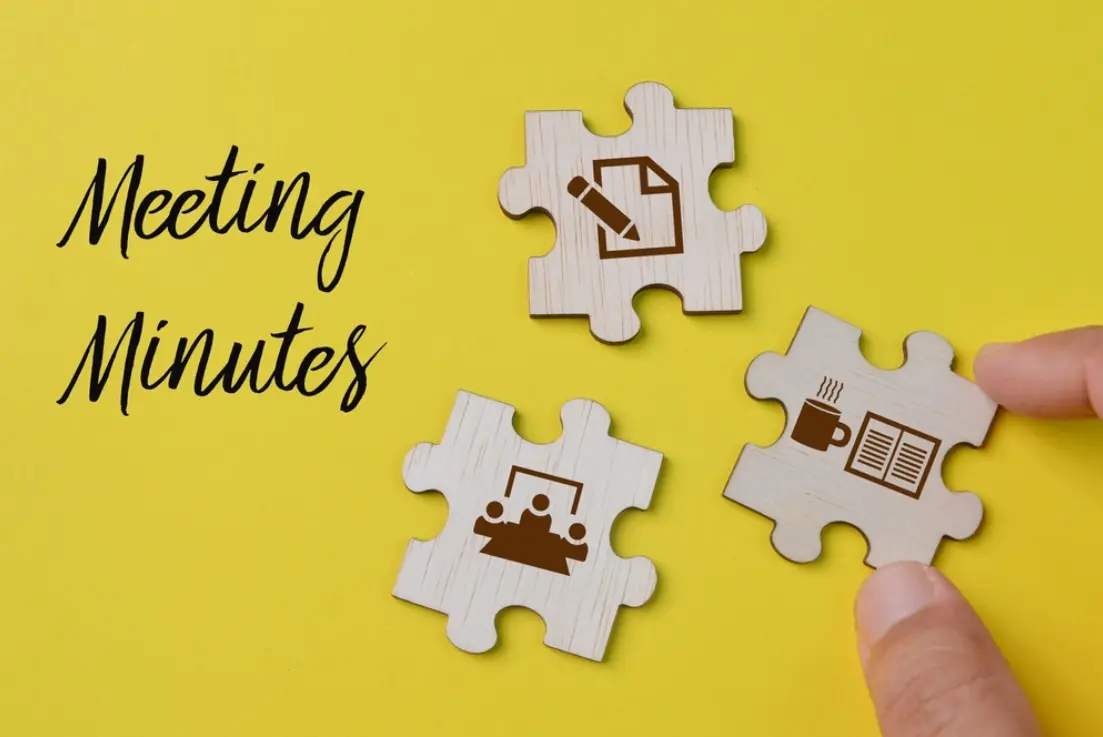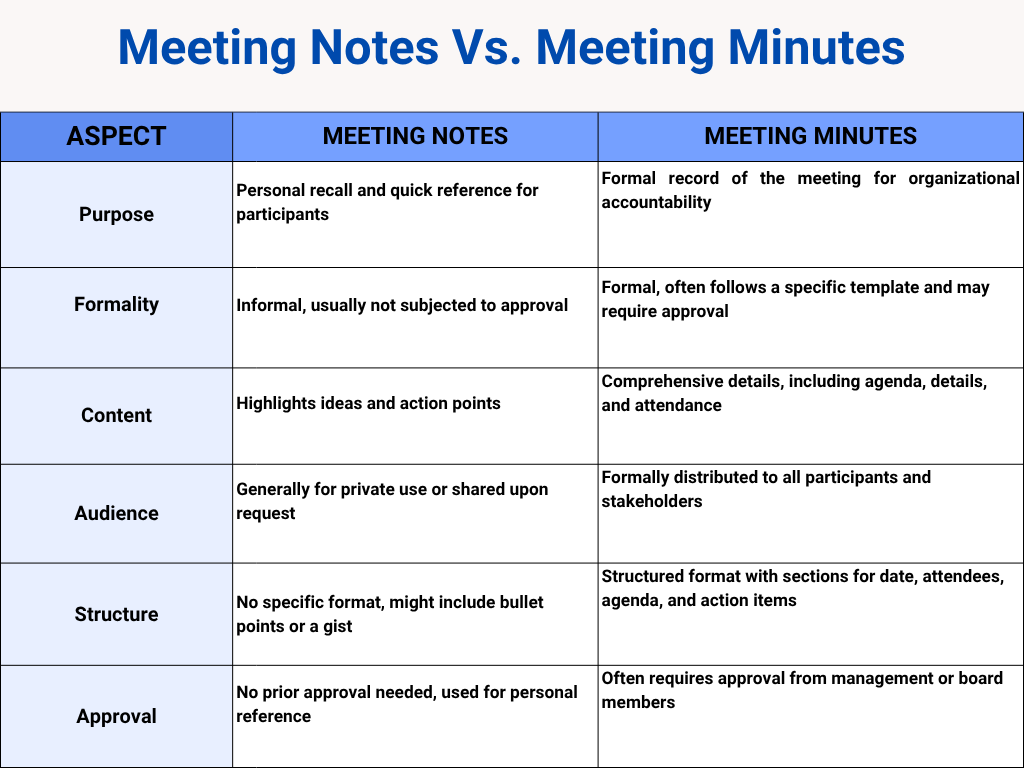Every working professional is aware that meetings are an essential part of the workforce. Meetings help organizations discuss important topics like deadlines of projects, milestones achieved, objectives of the organization, and many other important items. So, if you are someone who forgets everything the moment the meeting is over, meeting notes and meeting minutes are your best allies. Both are useful tools that help in documenting the meeting and serve specific purposes. Not many are aware of the difference between meeting notes and meeting minutes. Thus, here we will establish how Meeting Notes differ from Meeting Minutes.

Jump ahead to
Meeting Notes
Meeting Notes are nothing but a summary of important details discussed during the meeting. These are exactly what the name implies – notes written on a document. They are quick reference points that any participant in the meeting can take. Some of the important components of meeting notes are ideas, deadlines, milestones, goals, etc. The main objective of meeting notes is to help in remembering the important details of the meeting. These are informal and do not have a fixed format. When written in an organized yet simple manner, these notes help professionals remember the important details of the meeting. So, for professionals taking meeting notes during a meeting can be very productive and help them in achieving their work goals.
Meeting Minutes
Meeting Minutes or Minutes of Meeting abbreviated as MoM are a formal documentation of a meeting. They are a detailed record of the meeting and include details like a list of the attendees and absentees of the meeting. The MoM documents also have include the start and end timings of the meeting. They also help professionals in recording the key topics discussed, actions or votes taken, and decisions made during the meeting. Usually, one of the participants of the meeting is responsible for taking minutes of the meeting. In some cases, the minutes-taker is the project manager itself or a professional assigned by the project manager. Since MoM documents are formal, they are generally used for official record purposes like Board Meetings, Auditor briefings, and Court proceedings.
Meeting Notes vs. Meeting Minutes

From the above outline of meeting notes and meeting minutes, we can conclude that both meeting notes and meeting minutes are an excellent form of documentation for meetings. In a meeting minutes document, the information is more detailed and structured as compared to meeting notes. The meeting notes can have the same information as the meeting minutes in an informal manner. Both meeting notes and meeting minutes are a real-time record of the meeting. Therefore, they follow a similar pattern of using shorthand and abbreviations to write the important details of the meeting. They must be logical and sensible so that everyone can understand them. These similarities between meeting notes and meeting minutes are the reason why both terms are sometimes confused with one another.
To understand the distinction more clearly, here’s a detailed comparison between Meeting Notes and Meeting Minutes based on key aspects:
- Purpose: The main use of Meeting Notes is personal recall. They provide the participants with a quick way of writing down the main ideas, action points, and reminders, which are helpful for their individual follow-up. Besides, they are aimed at making personal organization of work easier. Meeting Minutes, however, play the role of the formal record of the meeting where the discussions, decisions, and the people assigned to carry out the tasks are all registered, making it a formal reference for future accountability.
- Formality: Meeting Notes are of an informal character and are usually not subjected to any specific format or approval process. They are written spontaneously and are mainly for capturing ideas as they flow. On the other hand, Meeting Minutes are formal documents that generally conform to a certain template, require prior appointment of a minute-taker, and sometimes, they are even reviewed or approved by higher management or board members.
- Content: Meeting Notes capture quick highlights that are relevant to the note-taker, including relevant points, ideas, or next steps. Notes from a meeting are usually short, selective in nature, and easy to read and skim through. Whereas minutes account for more comprehensive notes. It includes details such as the agenda of the meeting, details around participants, the time, discussions, motions, or votes conducted, along with the decisions made, meeting elements, and other important details. However, minutes record every detail that is significant in the meeting.
- Audience: Meeting Notes are generally meant for private use or shared only on request with colleagues who need a summary. Besides, they are a means of keeping the professionals informally aligned regarding the next steps. Meeting Minutes, on the other hand, are formally distributed to participants, absent members, senior management, or stakeholders for the purpose of ensuring transparency and keeping everyone aligned on decisions and outcomes.
- Structure: Meeting Notes allow for an open, more relaxed structure that is based on the note-taker. Meeting Notes might consist of bullet points, abbreviated sentences, or quick summaries. Meeting Minutes, however, have a more structured, formalized format that is often dictated by the organization and includes a section for the date, attendees, and agenda items, while also including a section for action items to keep a clear and formal record for organizational accountability.
The following table cohesively addresses the differences between Meeting Notes and Meeting Minutes:
| Aspect | Meeting Notes | Meeting Minutes |
| Purpose | Personal recall and quick reference for participants | Formal record of the meeting for organizational accountability |
| Formality | Informal, usually not subjected to approval | Formal, often follows a specific template and may require approval |
| Content | Highlights ideas and action points | Comprehensive details, including agenda, details, and attendance |
| Audience | Generally for private use or shared upon request | Formally distributed to all participants and stakeholders |
| Structure | No specific format, might include bullet points or a gist | Structured format with sections for date, attendees, agenda, and action items |
| Responsibility | No designated note-taker, any participant can take notes | Designated minute-taker is appointed before the meeting |
| Approval | No prior approval needed, used for personal reference | Often requires approval from management or board members |
Adding these distinctions helps illustrate how meeting notes emphasize convenience and personal efficiency. On the other hand, meeting minutes focus on precision, formality, and organizational accountability.
How are Meeting Notes different from Meeting Minutes?
Here are 6 key differences between Meeting Notes and Meeting Minutes:
- Meeting Notes are informal whilst meeting minutes are a formal documentation of a meeting.
- Meeting Minutes is a transcript of the meeting whereas meeting notes mention the important details of the meeting only.
- A MoM document is structured and has a template. There is no structure to meeting notes as they depend on the individual style and preference of the note-taker.
- Minutes of Meeting detail the agenda of the meeting and are shared with the participants. While meeting notes are kept for personal reference and are not shared with other attendees or absentees of the meeting.
- Minutes are taken by a designated minutes-taker and are assigned prior to the meeting. There is no need to have a designated note-taker because notes are taken for recall and remembrance.
- The minutes-taker can prepare the MoM template in advance and share the agenda of the meeting with the participants. The project manager or the board members can approve the MoM document before the meeting. Meeting Notes do not require any prior approval.
Although meeting notes are used for personal reference, they can be shared with other attendees or absentees of the meeting at their request. Thus, it is vital that the note-taker follows a simple and organized method for taking meeting notes. Both meeting notes and meeting minutes help in increasing the productivity of the organization. By recording important details of the meeting, professionals can stay updated with their tasks and successfully attain the objective of their organizations.
Important company meetings or board meetings must have a definitive plan like a board meeting agenda and recording board meeting minutes to become more productive. This helps organizations to check the progression of multiple organizational operations as well as keep a track of the long-term goals. Sharing the board meeting agendas among the participants of the board meeting in advance and transcription of the meeting using board meeting minutes will improve the effectiveness of the meeting.
Conclusion
Therefore, we have established that meeting notes and meeting minutes are two different forms of documentation of a meeting. Both meeting notes and meeting minutes are recorded in real-time and are written in a clear and concise manner. They help stakeholders of the organization remember important details of the meeting when they are written in a simple and organized format.
Project Managers usually use meeting notes more frequently than meeting minutes as they are more suitable for a formal setting. However, they must be knowledgeable in taking effective meeting notes as well as meeting minutes. Aspiring project managers can learn about the right way to take meeting notes and meeting minutes along with a thorough understanding of the project management methodology using our PMP (Project Management Professional) Certification Training Course. This will help them in earning the prestigious PMP Certification from the Project Management Institute (PMI) and successfully attain the long-term objectives of their organizations.
Download Free Meeting Minutes Template here.
FAQS on Meeting Notes vs. Meeting Minutes
1. What are meeting notes?
Meeting notes are informal outlines of major points that have been discussed and are mainly concerned with essentials and action points.
2. What are meeting minutes?
Meeting minutes are formal papers capturing a detailed account of the meeting including participants, conversations, and decisions taken.
3. Why are meeting notes useful?
Meeting notes help to remind individuals of the important matters and the corresponding actions taken thus providing a very quick reference for the individual’s organization.
4. Why are meeting minutes important?
Meeting minutes give a formal record for accountability and transparency and thus, facilitate the tracking of decisions and actions made during meetings.
5. Who usually takes the meeting minutes?
The minute-taker who has been assigned the task, usually before the meeting, is responsible for the formal documentation of the minutes.
6. Can meeting notes be shared?
Yes, meeting notes can be shared if it is asked for, but it is intended for personal use.
7. What content is included in meeting minutes?
Meeting minutes usually consist of the agenda, discussions, action points, and meeting results.
8. How formal are notes with respect to minutes?
Notes are informal and flexible, while minutes are strict and structured, usually going through vetting or approval.
9. Are meeting notes subjected to approval?
Meeting notes do not need approval as they are mainly personal reference tools.
10. Can you give me tips on how to be a better note-taker?
Organizing, summarizing, using bullet points, and focusing on the critical points are some of the ways to improve note-taking during meetings.



